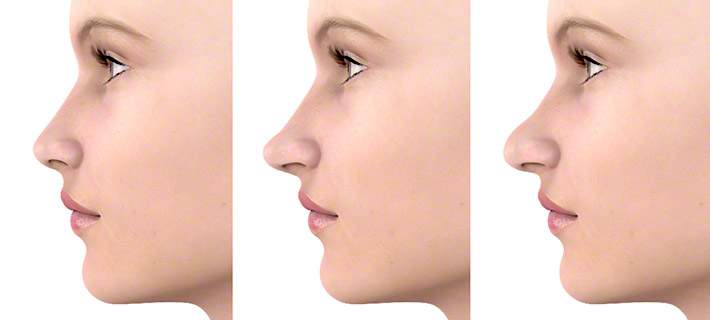In most cases, the nose tip rhinoplasty is a part of the generally performed rhinoplasty.
That’s the reason why we perform the nose tip surgery at Yuveo in Düsseldorf in combination with removing a hump of the nose or with a nose reduction.
Content
Yuveo Klinik
Characteristics of the nose tip surgery
Within the scope of the rhinoplasty, the nose tip rhinoplasty demands the most precise work.
Raising the tip
Narrowing the tip
Lowering the nose tip
Nose tip surgery
There are as many techniques for nose tip rhinoplasty as there are grains of sand on the beach.
The alar cartilage can be narrowed in the area that faces the roof of the nose. If the cartilage is weakened too much, a collapse of the vestibule on inspiration is possible, in which the air supply is restricted in an uncomfortable way.
A ball-like nose tip can be corrected through stitching the alar cartilages together. So-called mattress sutures can strengthen the effect.
If the alar cartilage, taken as a whole, is too widely based, it must be shortened in the horizontal direction through removal of a segment or through shifting of one half into the other.
Also, it often makes sense to strengthen the columella by means of a cartilage graft to maintain stability when more marked correction is made in the area of the nasal tip.

FAQ: Nose Tip Surgery
What is the difference between nose tip rhinoplasty and rhinoplasty?
The nose tip rhinoplasty is, for the most part, only one component of the standard rhinoplasty. However, there are cases, in which malformation of the nose tip exists in an otherwise normal nose.
Cartilage and soft tissue
In the former, no bony structures are modified. It is a procedure involving cartilage and soft tissues. Therefore a nasal splint in the case of a simple nose tip rhinoplasty does not have to be worn as long. However, it is recommended by many nose surgeons to avoid swelling and hematomas.
General anesthesia
The nose tip rhinoplasty can, it is true, be performed under local anesthesia in principle, with twilight sleep if necessary, but the anesthetic injections are very painful, so that here too, general anesthesia is recommended.
Open approach
For a more marked molding of a nasal tip, an open approach is usually necessary. Only in this manner can one recognize and revise the structures perfectly. Therefore, as a rule, an open approach is chosen for a nose tip rhinoplasty.
What can be achieved through nose tip surgery?
In principle, various surgical techniques for the nose tip rhinoplasty exist, all of which will not be elucidated in detail. However, here are a few points:
Nasal tip lifting
It can be achieved through shortening the inferior anterior portion of the nasal septum, narrowing the alar cartilage (palpable on the nose tip and often visible as a double bead), and by means of fixed inner sutures to secure the alar cartilage.
Narrowing of the nose tip
To attain a narroewing through the nose tip rhinoplasty, the alar cartilage can be molded using sutures. Sometimes the cartilage must be divided and newly sutured. Occasionally, cartilage transplantations are necessary to form the tip when a globe-like deformity is involved.
Reduction of the nose tip
This can be accomplished through shortening the anterior superior portion of the nasal septum and the alar cartilage. If an extensive reduction must be achieved with the nose tip rhinoplasty, the nares can appear too large. This can be corrected through shortening the nasal alar wings (Wedge Excision) in the area of the nasofacial sulcus.
Stabilization of the columella
In the case of soft cartilage support can be attained with a small cartilage transplant (so called columella strut) which is obtained from the nasal septum.
What is involved in the postoperative care?
After the nose tip rhinoplasty it is usually advisable to wear a nasal splint for a few days, even though no bones were broken.
This should prevent the development of a hematoma or persistent swelling between the skin and the cartilaginous structures.
The stitches in the columella are removed after about 10 days.
Overall, the healing phase after a nose tip rhinoplasty is considerably shorter than after a complete rhinoplasty.
With a nose tip that was originally quite wide, one must be somewhat patient after the nose tip rhinoplasty. Even if the inner support has now been corrected, the outer skin still has to contract. This can take months.
What complications can occur during nose tip rhinoplasty?
In the case of the nose tip rhinoplasty, the probability of the occurrence of complications is less overall than with a standard rhinoplasty.
However, in principle, almost all the complications can occur that are described in the rhinoplasty article.
Checking the facts
- Surgeon: Dr. Schumann
Treatment duration:
45 min to two hours- Anaesthesia
General anaesthetic - Hospital:
one day - Postoperative care:
Nasal splint, cooling, elevate head - Remove stitches:
after 10 days - Sports:
The nose is sensitive to impact, therefore avoid sport for 4 to 6 weeks after the operation.
Further Information

